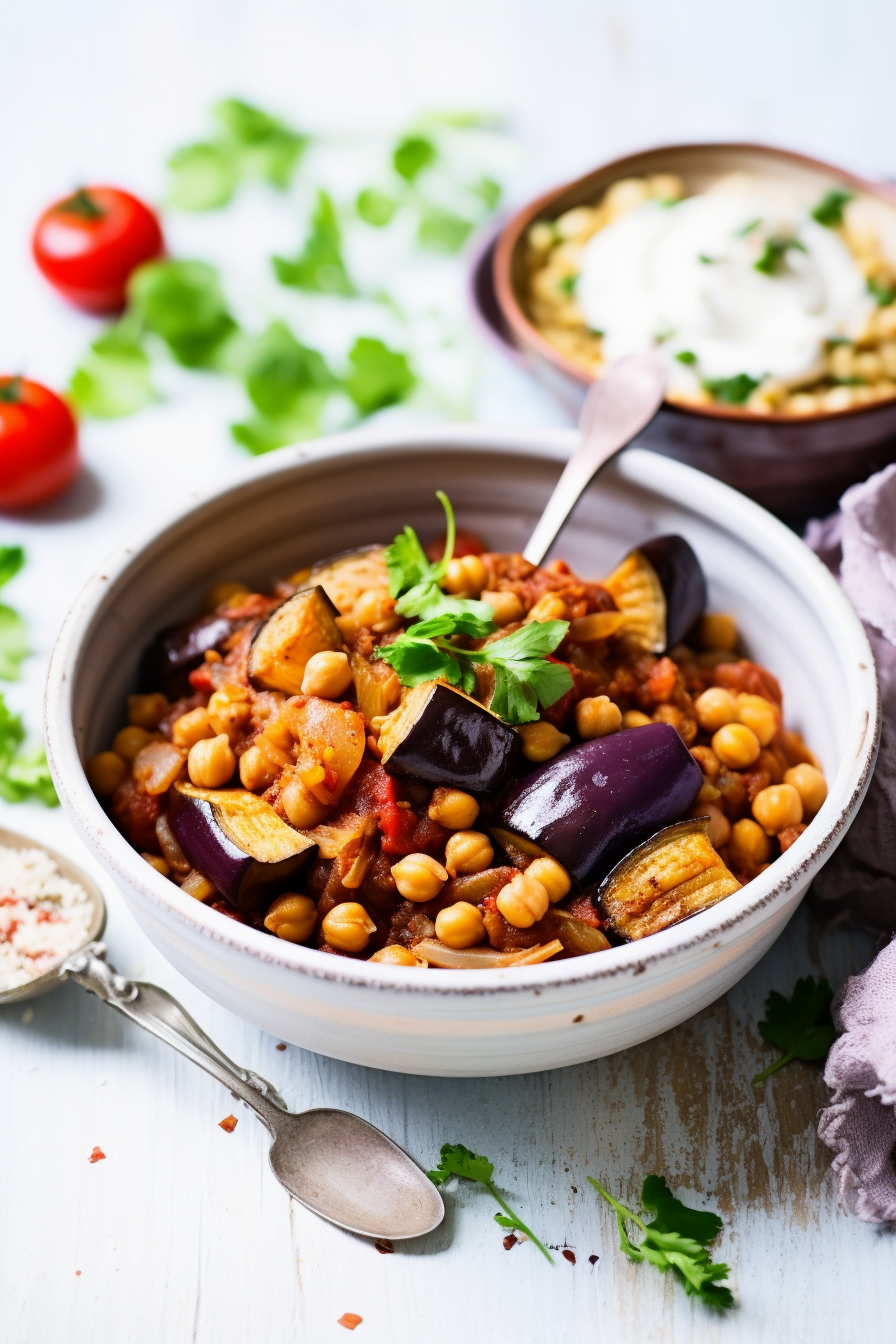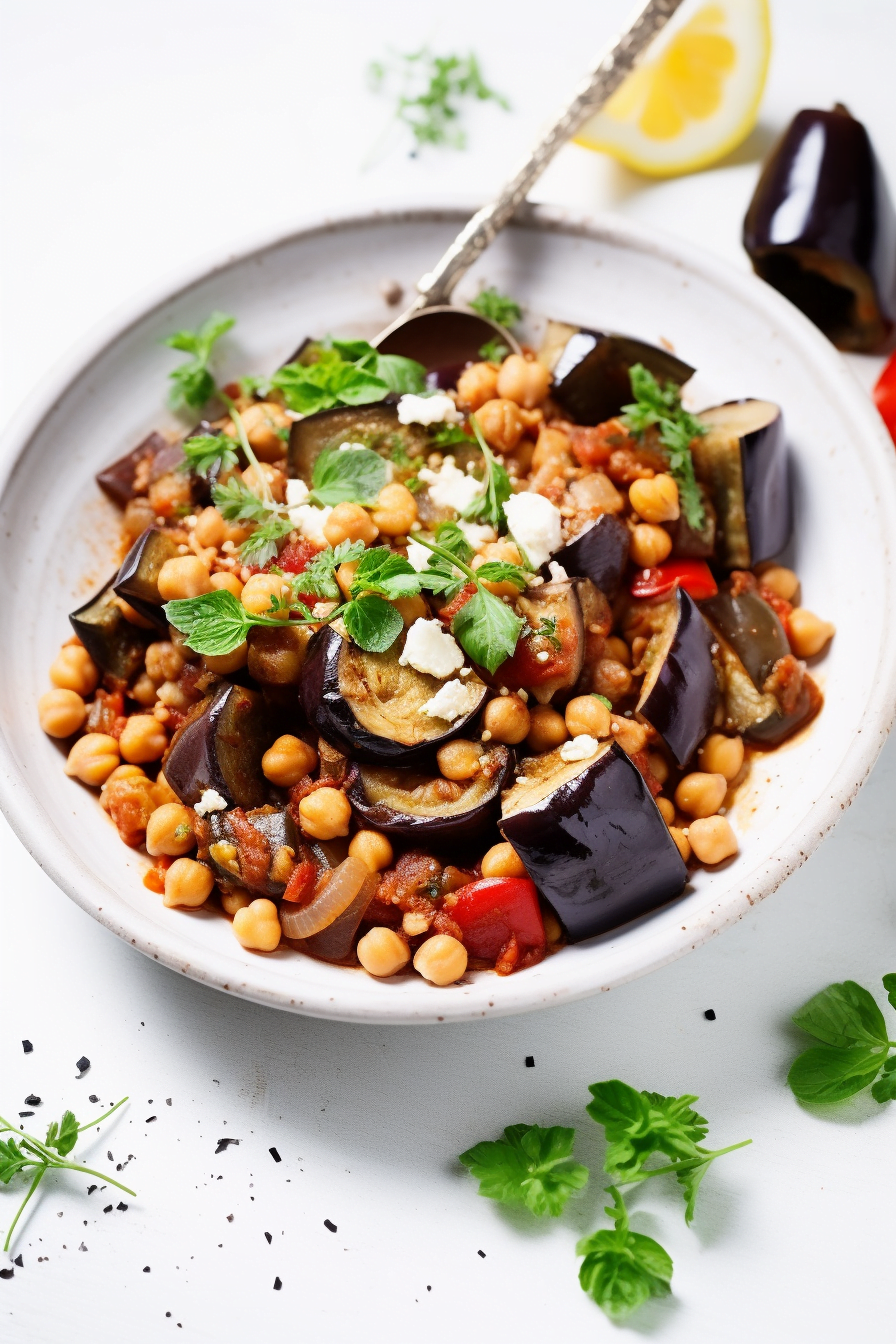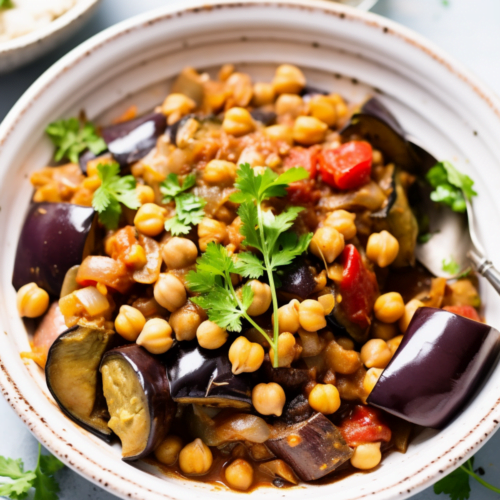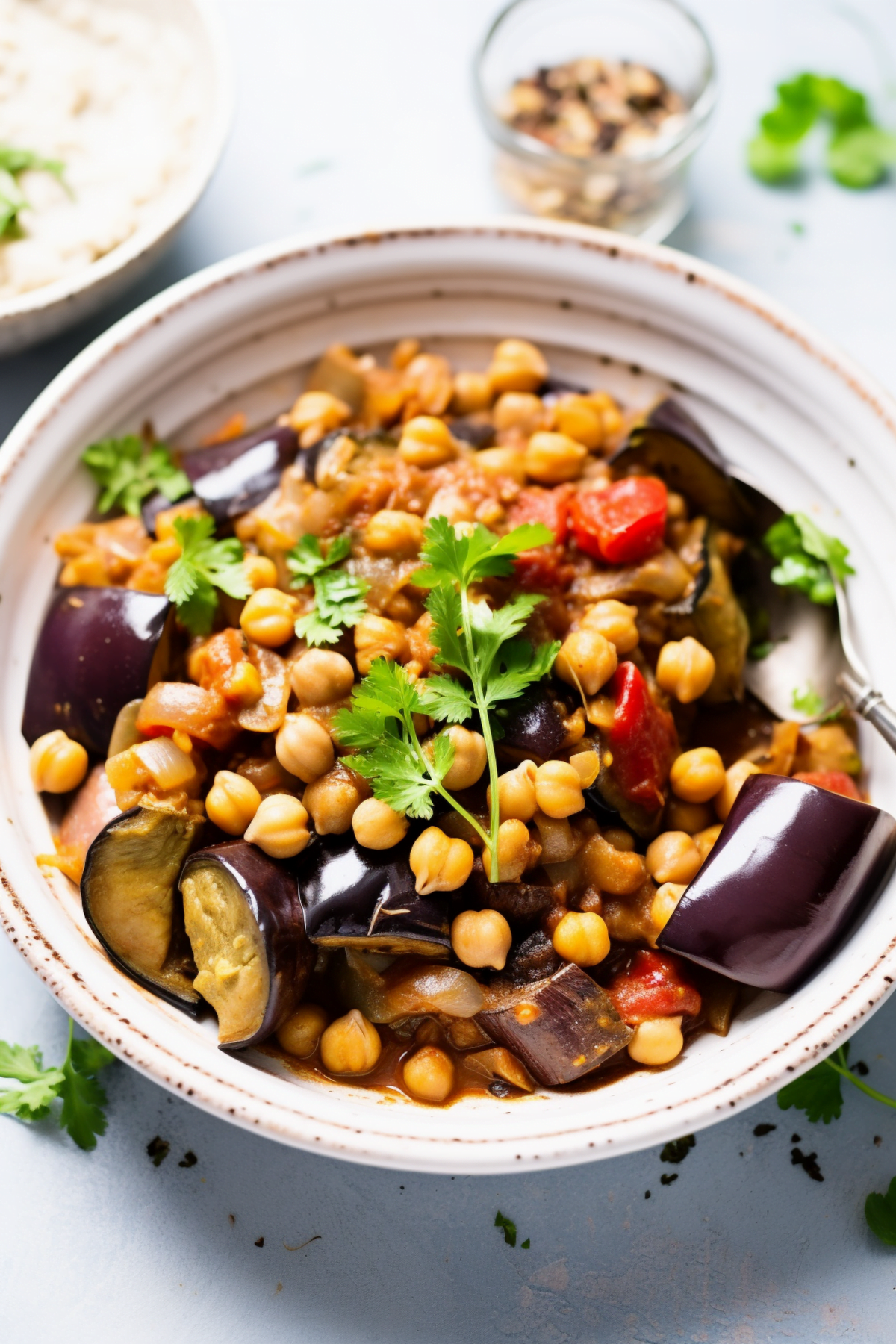Discover the Warmth of Syrian Cuisine with Eggplant and Chickpea Stew
Embark on a culinary journey to the heart of the Middle East with a dish that encapsulates the essence of Syrian cooking. The Syrian Eggplant and Chickpea Stew with Cumin is a rich tapestry of flavors, bringing together the earthiness of cumin, the creamy texture of chickpeas, and the unique savoriness of eggplant. This stew is not just a meal; it’s a celebration of Syrian heritage, perfect for those seeking a comforting and nutritious dinner option.
Whether you’re a vegetarian or simply a lover of hearty, plant-based meals, this stew promises to satisfy. It’s a dish that warms the soul and fills the kitchen with inviting aromas. Let’s delve into the recipe that will soon become a staple in your culinary repertoire.

The Story Behind Syrian Eggplant and Chickpea Stew
The origins of this stew can be traced back to the bustling markets of Damascus and Aleppo, where spices like cumin and coriander are staples in the Syrian pantry. This stew, known locally as Batata wa Ra’s, is a testament to the resourcefulness of Syrian home cooking, which often revolves around seasonal vegetables and legumes. The use of cumin is particularly significant as it’s a spice that has been used for centuries in the region, not only for its flavor but also for its purported health benefits.
Eggplants, or aubergines, thrive in the Mediterranean climate and are a cornerstone of Syrian cuisine. They are celebrated for their versatility and ability to absorb flavors. Chickpeas, on the other hand, are a source of protein and fiber, making this dish as nutritious as it is delicious. The combination of these two ingredients creates a stew that is hearty yet surprisingly light, suitable for any season.
Traditionally, this stew would be cooked in a large pot over an open flame, allowing the ingredients to simmer and meld together slowly. The key to its depth of flavor lies in the layering of spices and the patience in allowing the eggplant to cook to tender perfection. It’s a dish that reflects the Syrian ethos of hospitality, meant to be shared with family and friends.
As we explore this traditional Syrian recipe, we invite you to embrace the simplicity and elegance of its flavors. The Syrian Eggplant and Chickpea Stew with Cumin is more than just a meal; it’s a culinary experience that connects you to the rich tapestry of Mediterranean culture.

Mastering the Method
Creating this stew is about embracing the traditional Syrian approach to cooking, where each step is an opportunity to build flavor. Begin by selecting the freshest eggplants you can find, looking for a glossy skin and firm texture. When you sauté the eggplant, ensure it’s golden brown; this caramelization is crucial for developing the stew’s rich flavor profile.
As you sauté the onions and garlic, be mindful not to rush this step. The onions should become translucent and the garlic fragrant, which will form the aromatic foundation of the stew. When adding the spices, take a moment to toast them slightly. This releases their essential oils, which enhances the stew’s overall flavor.
When incorporating the tomatoes, allow them to break down and meld with the spices. This creates a saucy base that will coat the eggplant and chickpeas beautifully. As the stew simmers, it’s essential to stir occasionally to prevent sticking and to ensure even cooking.
Remember, patience is key. The stew should be thick and the flavors well integrated. It’s not just about following a recipe; it’s about engaging with the process and allowing the ingredients to reveal their full potential. Serve the stew with a generous garnish of fresh cilantro or parsley, which adds a bright note to the dish, and lemon wedges to provide a zesty contrast to the rich flavors.
By following these tips and taking your time, you’ll create a stew that is authentic, flavorful, and deeply satisfying. This Syrian Eggplant and Chickpea Stew with Cumin is more than just sustenance; it’s a dish that tells a story with every spoonful.

Variations to the Classic Stew
With Meat
For those who prefer a non-vegetarian version, adding chunks of lamb or beef can transform this stew into a more robust meal. The meat should be browned before the vegetables are added, ensuring it’s well-seared and flavorful.
Spicy Kick
If you enjoy a bit of heat, consider incorporating a diced chili pepper or a teaspoon of harissa paste. This will add a fiery dimension to the stew that complements the earthy spices beautifully.
Winter Warmer
In the colder months, adding root vegetables such as carrots or potatoes can make the stew even heartier. These should be cut into small cubes and added with the eggplant to ensure they cook evenly.
Substitutions for Dietary Needs
Understanding the versatility of this stew is key to making it accessible for all dietary preferences and restrictions. Here are some thoughtful substitutions:
Gluten-Free
For a gluten-free option, ensure that the vegetable broth used is certified gluten-free. Many store-bought broths contain gluten, so always check the label or make your own at home.
Low-Fat Version
To reduce the fat content, you can opt for less olive oil or use a cooking spray. Additionally, consider using a light vegetable broth or water to further cut down on calories.
Vegan-Friendly
This stew is naturally vegan, but if you’re looking to add a creamy element, consider stirring in a dollop of coconut milk or a vegan yogurt towards the end of cooking.
Frequently Asked Questions
Here are some common queries you might have when preparing this stew:
Can I use dried chickpeas instead of canned?
Yes, you can use dried chickpeas, but they will need to be soaked overnight and cooked until tender before adding them to the stew.
How can I prevent the eggplant from absorbing too much oil?
Salt the eggplant cubes before cooking them; this helps to draw out moisture and can reduce the amount of oil they absorb.
Is it possible to make this stew in a slow cooker?
Absolutely, you can prepare the stew in a slow cooker. Sauté the vegetables as instructed, then transfer everything to the slow cooker and cook on low for 4-6 hours.
How do I store leftovers?
Leftover stew can be stored in an airtight container in the refrigerator for up to 3 days. The flavors often deepen with time, making it even more delicious the next day.
Can I freeze this stew?
Yes, this stew freezes well. Cool it completely before transferring it to freezer-safe containers. It can be stored in the freezer for up to 3 months.

Syrian Eggplant and Chickpea Stew with Cumin
Equipment
- Large pot
- Cutting board
- Chef's knife
- Measuring cups and spoons
- Wooden spoon
Ingredients
- 2 medium eggplants (about 1 lb or 450g) cut into cubes
- 1 can chickpeas (15 oz or 425g) drained and rinsed
- 1 large onion (about 8 oz or 225g) finely chopped
- 3 cloves garlic minced
- 2 large tomatoes (about 1 lb or 450g) diced
- 1 tsp ground cumin
- 1/2 tsp ground coriander
- 1/4 tsp cayenne pepper
- 1/4 cup olive oil
- 2 cups vegetable broth
- Salt and pepper to taste
- Fresh cilantro or parsley for garnish
- 1 lemon cut into wedges for serving
Instructions
- Heat half of the olive oil in a large pot over medium heat. Add the eggplant cubes and cook until they are golden and softened, about 10 minutes. Remove the eggplant from the pot and set aside.
- In the same pot, add the remaining olive oil and sauté the onions until translucent, about 3 minutes. Add the garlic and cook for another minute until fragrant.
- Stir in the ground cumin, ground coriander, and cayenne pepper, cooking for a minute to release their aromas.
- Add the diced tomatoes and cook for 5 minutes, until the tomatoes are softened and the mixture becomes saucy.
- Return the eggplant to the pot and add the chickpeas. Pour in the vegetable broth and bring the mixture to a simmer.
- Cover the pot with a lid and let the stew simmer for 25 minutes, stirring occasionally. The stew should thicken and the flavors will meld together.
- Season with salt and pepper to taste. Serve hot, garnished with fresh cilantro or parsley and lemon wedges on the side.
Notes

